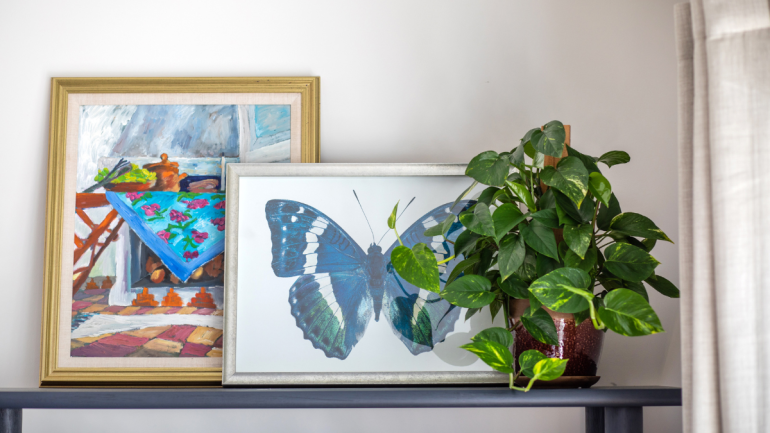By Nat Wexler | Photography by Shanna Wolf
Spring weather in the Midwest, especially southeastern Wisconsin, is often extremely unpredictable. At this time of year, we can experience all four seasons in a matter of hours, which means that outdoor gardening has to wait until very late in the season when the threat of frost has fully passed. For those who are looking to keep their green thumbs in the game before the ground thaws, however, the solution lies close to, or rather inside, the home.
Houseplants are an excellent way for gardeners to enjoy the beauty and benefits of plants year-round. In addition to the visual charm they add to any space, houseplants are known to boost mood and improve indoor air quality, and many indoor plants even offer medicinal benefits. That makes indoor gardening a perennial activity with lasting benefits.
In a study published in the journal Frontiers in Psychology, scientists have found a correlation between houseplants and improved mood — in short, people who live in homes with plants tend to be happier than those who don’t. Studies show that individuals who take care of plants also report lower stress levels than those who do not, as well as decreased levels of depression and anxiety. Some mental health professionals even prescribe the care of indoor plants to their patients as a treatment tool.
Plants may help to boost indoor air quality by clearing out carbon dioxide and producing oxygen, while helping to remove pollutants and volatile organic compounds (VOCs) from the air. During the photosynthesis process, which is the chemical change that creates the energy a plant needs to survive, plants combine the carbon dioxide in the air with water and sunlight. As a result of this process, oxygen is released into the air. Therefore, having plants in a space can decrease the amount of carbon dioxide and other irritants in the air and increase the amount of oxygen.
Additionally, the leaves of a plant can act as a filter to catch airborne particles that can be irritating to humans when inhaled. (Though it is important to note that plants that produce pollen or spores do not provide this benefit and can be detrimental to those with allergies or weakened immune systems.)
A number of houseplants can have medicinal benefits. For example, plucking a leaf off an Aloe vera plant and applying the gel inside to a minor burn or skin irritation (but not an open wound!) can provide some natural relief. Chewing on mint leaves or steeping leaves from a mint plant in hot water for tea can help to relieve symptoms of indigestion and increase an individual’s intake of Vitamin A. Some studies have even shown that people who are recovering from surgery heal faster when there are plants present in their hospital rooms.
To take advantage of these potential health benefits, it’s important to choose the correct plants for your environment and lifestyle. “Plants need three things to live: light, air and nutrients,” explains Brenda Williams of Pesche’s Greenhouse. “Many people believe that water is the most important element, but I think it is light.”
Because of this, plants should not be placed in a dark or windowless space. Light is so important that, Williams says, “a plant without light will show detrimental growth in just a few days.” Additionally, some plants require frequent watering, making them more high-maintenance than other plants, and therefore are not well-suited for people who travel frequently or lead busy lives. And of course, before selecting a plant for a space with children or animals, it is important to ensure that the plant is not harmful to them if touched or ingested.
So what are a few plants that can help brighten up any indoor space and ease the long thaw until it’s time to head back outside?
- Zanzibar Gem (ZZ Plant). These plants are known to survive droughts and as a result, they do not require watering every day. These plants thrive when placed in bright rooms with indirect light, so make sure to occasionally move them around the house for optimal health.
- Aloe vera plant. This medicinal plant needs to be in a bright and sunny space. Because it is a desert plant, Aloe vera should not be kept in moist soil. They should only be watered when their soil has completely dried out, about once every two weeks or so. When removing a leaf for its gel, snip the leaf using scissors as close to the stem as possible.
- Fresh herbs. Local garden designer Katie Oglesby recommends growing your own fresh herbs instead of processed spices since they are “much healthier and more flavorful.” Make sure to remove the leaves from their stem before adding the herbs to a recipe. Fresh herb plants like rosemary, thyme, mint, basil, parsley, oregano or sage grow well indoors. These plants need to be watered a few times a week, and most need roughly 4-8 hours of sunlight a day.
- Lavender. This plant is not only beautiful to look at, but it also offers a multitude of health benefits. The scent of lavender has been known to improve sleep and reduce stress levels. Initially, lavender needs to be watered twice a week, but after about a year, the plant can be watered more infrequently. In order to thrive, this plant needs full sunlight.
- Peace Lily. These plants can be placed in low light and low humidity areas, and they do not need to be watered every day. After studying the air effects of several indoor houseplants, NASA declared this one of the best plants for air purification. (Note that direct sunlight will burn the leaves of a Peace Lily, so finding the right spot in the house is important.)
- Ferns. These are very low- maintenance plants that thrive in low-light conditions, which makes them a perfect plant for those long stretches of Midwestern winter that feel devoid of any sunlight. However, ferns do require a certain humidity level to thrive, so pay attention to your indoor humidity levels.
- Orchids. For those looking to add some flowers to their indoor space, consider an orchid. Orchids are stunning flowers that require full sun but only need to be watered once a week. (Ideally, a daily mist of water will keep help to keep them from drying out.) However, orchids are notoriously fragile and prone to root rot, and as a result they require special soil, so make sure to do your research if you’re interested in these stunners.
- Monstera Deliciosa, aka the “Swiss Cheese Plant.” These aesthetically pleasing plants have large leaves that resemble Swiss cheese. They only require a good watering every one to two weeks. Like Peace Lilies, Monsteras should not be placed in direct sunlight because their leaves will burn and dry out.
- Succulents. Some varieties of succulents, such as snake plants, Echeveria and ox tongue plants, can thrive in low-light environments. Succulents can also be combined with small figurines, rocks and other elements in a glass vessel to build a terrarium, which can help add a little magic to any space.





